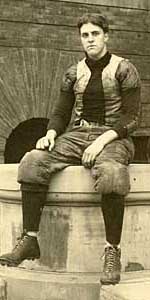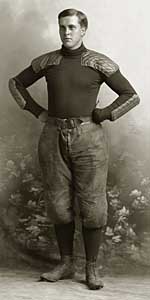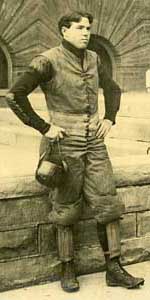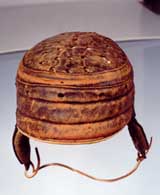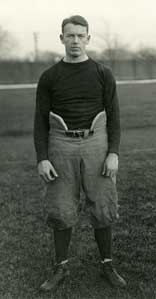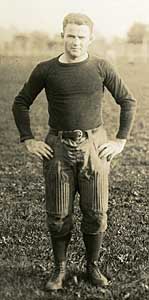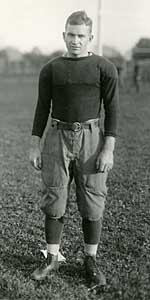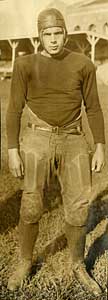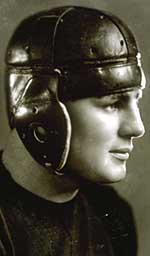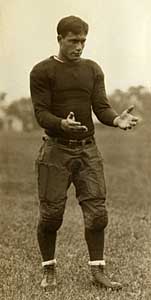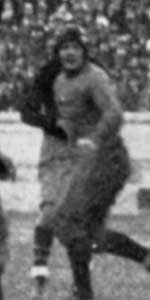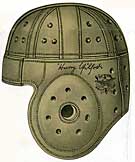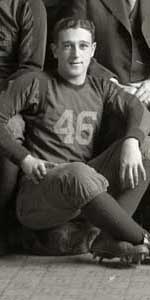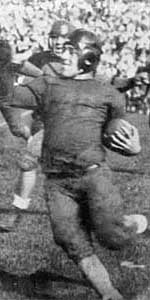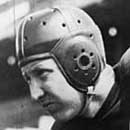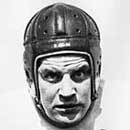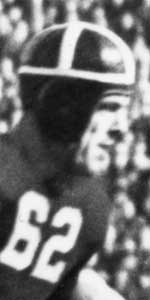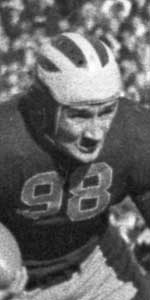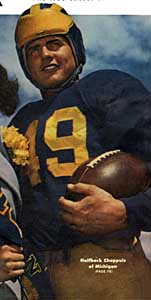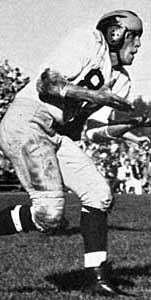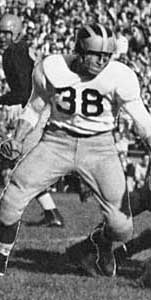Bentley Library | MGOBLUE | UM Football History | Uniforms, 1879-1899 | Uniforms 1900-1949 | Uniforms 1950-2979
Michigan Football Uniforms, 1900-1949
By 1900 the quilted style pants had largely given way to pants made of "moleskin" - a strong, twilled cotton fabric with a soft nap, giving it a slightly furry texture. The new moleskins usually included internal thigh and knee pads. The blue jersey with shoulder, elbow and forearm pads first appeared in photos in 1898 and would be the standard jersey from 1900 to 1911.
The
block M reached its modern form by 1902 and the letterman's sweater with high collar would be the dominant style through 1915.
Willie Heston's uniform in 1903-1904 included both shin guards and a helmet.
A variety of protective head gear began to appear in the late 1890s (see the 1898 alumni team photo for a few of the styles). By 1903 the helmet worn by Willie Heston had become a popular model. A few players continued to go helmetless through the early 1920s.
A plain blue jersey was adopted in 1911, replacing the external padding with shoulder pads worn under the jersey.
Photos from 1913 show three different style of pants then in use.
Numerals on the back of jerseys were introduced in1915. Number ranges were not yet associated with positions In some years the team captain wore #1 and other numbers were assigned alphabetically. It was not unusual for a player's number to change between seasons or even between games. At its December 1920 meeting the Western Conference adopted a resolution requiring all teams to "wear numbers not less than eight inches in height, the color being such as to show them distinctly." Teams were required to exchange rosters showing the numbers to be worn by eligible players at least one week before a game.
In the late teens some players began wearing jerseys with leather rib and elbow padding.
From the late teens into the mid-1920s, uniforms often included a girdle-like extension offering some hip and waist protection.
Wearing of helmets had become nearly universal by 1920 although the NCAA did not make it mandatory until 1939. Different models were frequently in use at the same time. The helmet worn by Edliff Slaughter was typical of the mid-to-late 1920s.
Both plain and padded blue jerseys were in use through the early 1930s
Michigan broke tradition for the 1928 Navy game played in Baltimore, and gave up its blue jerseys in deference to the Midshipmen's color. The Detroit Free press noted that the Wolverines "appeared strange in their bright yellow" jerseys. The black and white picture from the Michiganensian, hardly does the "canary yellow" justice.
Fielding Yost lent his name and nickname to a line of football equipment offered by he Wright & Ditson company. It is unclear if Michigan actually used any of the "Hurry Up" gear.
Numerals on the front of jerseys first appeared in the post-season 1930 varsity team photo. The 1931 team was the first to wear the jerseys with front numerals in games.
The story of Fritz Crisler's introduction of the winged helmet in 1937 is well known. It was supposed to help the passers more easily identify their intended receivers down field and to add a little flair to the Michigan uniform, Less well known is that the previous season Harry Kipke's team had added some decoration to their helmets. For two games in 1935 and the first three conference games of 1937 the team wore the white striped helmets but reverted to the unmarked version for of the remainder of the season.
Possibly the first face mask appeared in 1946 when halfback Gene Derricote wore one attached to a leather helmet for a few games.
Bob Chappuis (and fiancee Anne Gestie) appeared on the cover of LOOK magazine just before the 1948 Rose Bowl game.
It is one of the earliest known color photos of the Michigan Uniform.
Michigan adopted a molded plastic helmet in 1948, but unlike other
schools, U-M carried the winged design forward. A few players
continued wearing the leather helmet.
In 1949 white jerseys were adopted for the Northwestern and Illinois away games. Over the next two years white jerseys would become the rule for all away games, except in Columbus, where blue would be worn through 1956.

